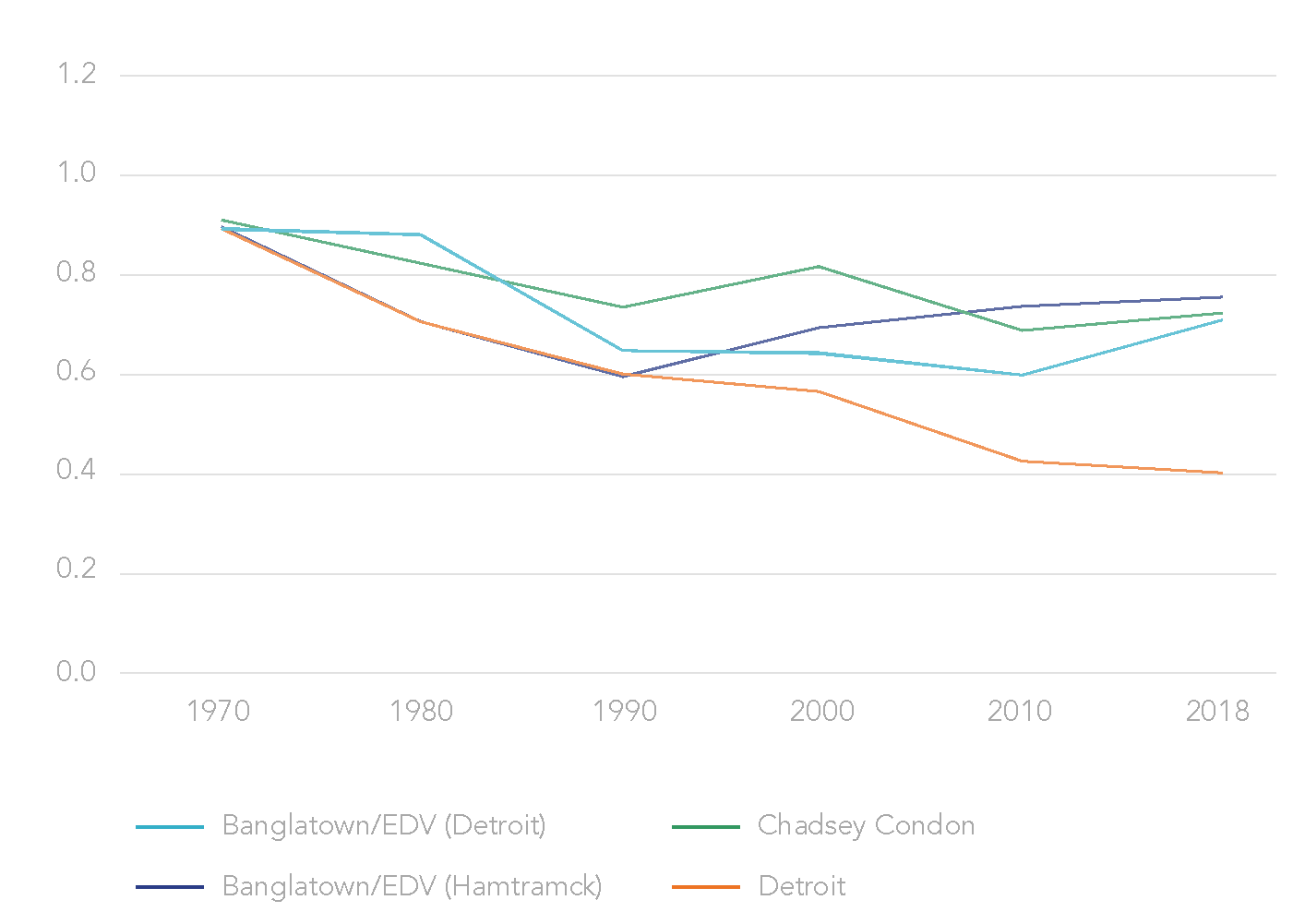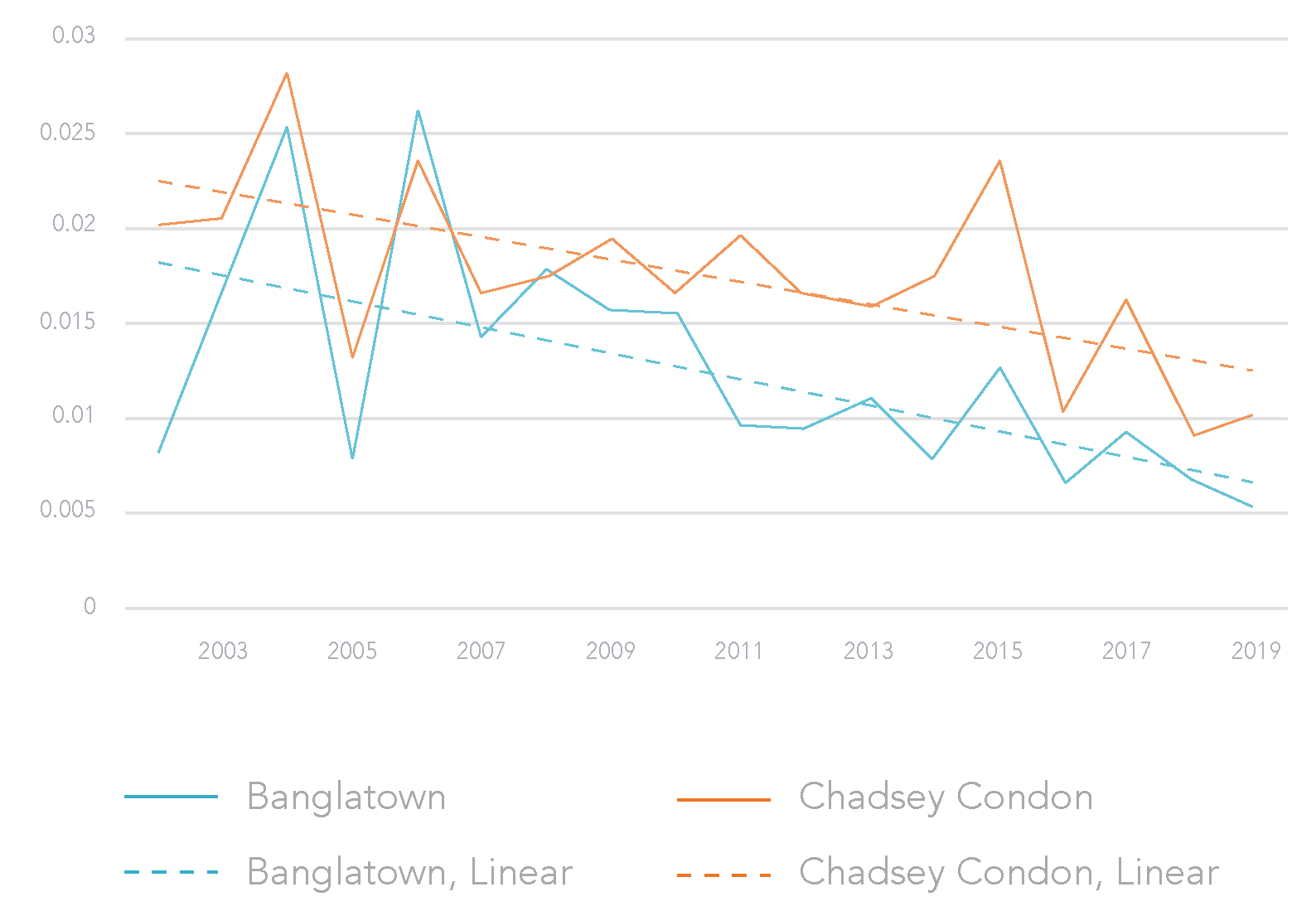Findings
Our research chronicles the positive contributions newer immigrant residents have made to neighborhood vitality in our subject neighborhoods in Detroit. This investment is occurring almost entirely from the ground up, without institutional support or massive public subsidy, and benefits, rather than displaces, long-term residents.
POPULATION STABILIZATION
Population loss has plagued the city of Detroit, leading to abandonment, vacancy, blight and associated ills. Detroit, like other post-industrial cities, has experienced more than a half century of continuous population loss and its current population of 670,000 less than 40% of its peak population of 1.8 million in 1950. Detroit’s mayor Mike Duggan has said that population growth is the single most important metric by which to judge the health of the city.

Population trends for subject areas and City of Detroit 1970 to 2018
Since 1990 the population trajectories of Banglatown/Davison and Chadsey Condon have differed sharply from the rest of the city. The overall population in these neighborhoods has stabilized as new immigrants moved into the community to replace residents who left the city or died. As a result, these two working-class neighborhoods have had stable population totals, while the city has continued to lose population over the past three decades, losing as much as a quarter of its population between 2000 and 2010 alone. Since 2010, the number of homeowners in the Detroit section of Banglatown/Davison has increased 12% and in Chadsey Condon by 15%. This is in sharp contrast to the city of Detroit, which saw a drop of more than 14,000 homeowners over the same period, with the homeownership rate falling below 50 percent for the first time since before World War II.
RESIDENT PERCEPTIONS & ATTITUDES
As part of this research study, in 2019 Global Detroit surveyed 100 residents in each of our study neighborhoods and asked quality of life questions identical to citywide surveys administered by the Detroit Metro Area Community Survey (DMACS) of the University of Michigan last administered in 2018. Residents in the Banglatown/Davison were more than twice as likely (85% compared to 37%) to report that the quality of life in their neighborhood was improving and about half as likely (8% compared to 16%) to say it was declining. Residents in Chadsey Condon were also much more likely (68% compared to 37%) to report that quality of life was improving and much less likely (6% compared to 16%) than residents citywide to say it was declining.


Similarly, 75% of residents in Banglatown/Davison saw their neighborhood as safer over the past five years compared to 22% of residents citywide and only 3% of residents in Banglatown/Davison saw conditions becoming less safe, compared to 21% of residents citywide. Similarly, 37% of Chadsey Condon saw their neighborhood as safer compared to 22% of residents citywide, while 13% of Chadsey Condon residents thought their neighborhood was less safe compared to 21% of residents citywide.
TAX DELINQUENCY & FORECLOSURE
One of the driving motivations for undertaking this research was a heat map of property tax delinquencies and foreclosures across Detroit that showed dramatically lower distress in Banglatown/Davison, a relatively low-income neighborhood. Our research found that the property tax delinquency rate in Banglatown/Davison in 2019 was 60% of citywide rates, while the rate for Chadsey Condon was 83% of citywide rates. From 2014–2019, rates in Banglatown/Davison declined 21%. Rates in Chadsey Condon fell 8% and those across the city fell 6%.

Tax foreclosures in Banglatown/Davison and Chadsey Condon as a percentage of citywide tax foreclosures in 2002 through 2019
Tax foreclosures have been a serious problem across the city of Detroit. While the number of foreclosures on an annual basis has dropped over the last decade with an improving economy and several new policies and programs designed to address the crisis, the rate of tax foreclosure in these two low-income neighborhoods studied have dropped even more significantly than the rates citywide. Together these neighborhoods accounted for about 4% of all Detroit tax foreclosure in 2002, but were less than 2% of citywide foreclosures by 2019. Since 2016, tax foreclosures in both neighborhoods have fallen precipitously.
EVICTION & VACANCY RATES
Eviction filing and eviction rates in both subject neighborhoods are considerably lower than the rest of Detroit, even though household incomes – a strong predictor of eviction risk – are close to citywide levels. The median eviction filing rate in the two neighborhoods is only one-quarter of the citywide rate, and the median eviction rate is one-third of the citywide rate. Lower evictions contribute to greater residential stability and lower rental turnover, both of which are beneficial for the families involved as well as for their neighborhoods.
Both Banglatown/Davison and Chadsey Condon are among the small number of neighborhoods in Detroit that are both lower-income and low-vacancy neighborhoods. U.S. Postal Service vacancy data presents a picture of a dramatic reduction in long-term housing vacancies in Banglatown/Davison from 2014-19, and a more modest, but still significant reduction in Chadsey Condon. Over those five years, the number of residential addresses vacant 90 days or more dropped by 42% in the Detroit portion of Banglatown/Davison, and the vacancy rate from 74% to 49% percent of the citywide rate. In Chadsey Condon, the change was more limited but still meaningful. The number of vacant residential addresses dropped by 24%, and the rate from 72% to 64% of the citywide rate.
